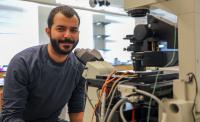Parsa Zareiesfandabadi
Parsa Zareiesfandabadi
North Carolina State University
2020
SPS Award for Outstanding Undergraduate Research
Project name
Microtubule-based forces power the spindle collapse following laser ablation in S. pombe
Biography
I am originally from Iran and moved to the United States as a refugee. My parents, who are part of a religious minority in Iran, encouraged me to leave my home when I was sixteen to seek a new and better life abroad. After living in Turkey for almost three years as an asylum seeker, the United Nations granted me entry to the U.S. as a refugee when I was nineteen. I remember feeling exhilarated for my new life, yet horrified to start from the bottom in a whole new world on my own. Things were not easy for several years. The language barrier, working overtime, and constant anxiety made it extremely difficult to stay in the community college that began my path to university. I persevered, and as I had hoped, things began to improve. As my English grew, I worked my way up at work, which made attending school easier.
I recently graduated from North Carolina State University, where I majored in Physics. I honed my research skills by working in a biophysics laboratory, the Elting Lab, where I researched the mechanics and dynamics of cell division. Shortly after I joined the laboratory, Dr. Mary Williard Elting invited me to join her in a new project centered around understanding the mitotic spindle (a complex molecular machine that separates the DNA during cell division), using yeast as a model organism. Along the way, I developed a solid background in programming, math, cellular and molecular biology, and chemistry. Working in this laboratory confirmed my potential as a researcher and made me determined to attend graduate school and work in pursuit of an academic career.
I get genuinely excited when I find something new to learn. Whether it be in natural or social science, what I deem most valuable is understanding a different way of thinking about an issue, a new perspective. I am passionate about our environment and enjoy discussing contemporary ethical and moral issues of our society. In my leisure time, I fancy running, cooking a delicious meal, practicing guitar, or reading.
What drives me to become a scientist is my ultimate goal of reducing social inequality by creating and providing opportunities to all classes of society. Advancing science and innovation is more impactful when channeled towards alleviating the worst of this world and where it is needed the most: poverty, inequality, disease, hunger, conservation, etc. I believe educating the next generation on these issues is the first step towards solving them. Combined with the opportunity for scientific innovation, I will create a fertile ground for affordable and accessible solutions. In short, I see my scientific career path as the way I can most effectively contribute to an egalitarian world.
Project abstract
A large molecular machine called the mitotic spindle is responsible for accurate chromosome segregation in eukaryotic cells. The spindle consists of protein filaments known as microtubules, which form a single bundle inside the nucleus in the fission yeast S. pombe. The spindle elongation via motor proteins is an internal source of extensile forces that is resisted by the compressive forces of the nuclear envelope and other materials inside of the nucleus. To discover the sources of this forces balance, we cut the spindle using focused laser light at various stages of cell division. We find that spindle pole bodies collapse toward each other post-ablation. Still, the spindle can often reattach and resume elongation. While this basic behavior has been previously observed [1,2], many questions remain as to the timing, mechanics, and molecular requirements of these phenomena. Here, we quantify the time scales of both the relaxation and rescue responses and probe their molecular requirements. We tested the possible mechanical roles of the nuclear envelope, DNA, and microtubule-based forces. We revealed that the microtubule-based forces power the collapse, and contrary to the previous hypotheses, the nuclear envelope and DNA do not elicit the collapse post-ablation. We will test the mechanical nature of microtubule-based motors and diffusive crosslinkers in generating directed forces along the microtubules.
Project references:[1] A. Khodjakov, et al. Curr. Biol., 2004.[2] I. Tolic-Nørrelykke et al, Curr. Biol. 2004.

